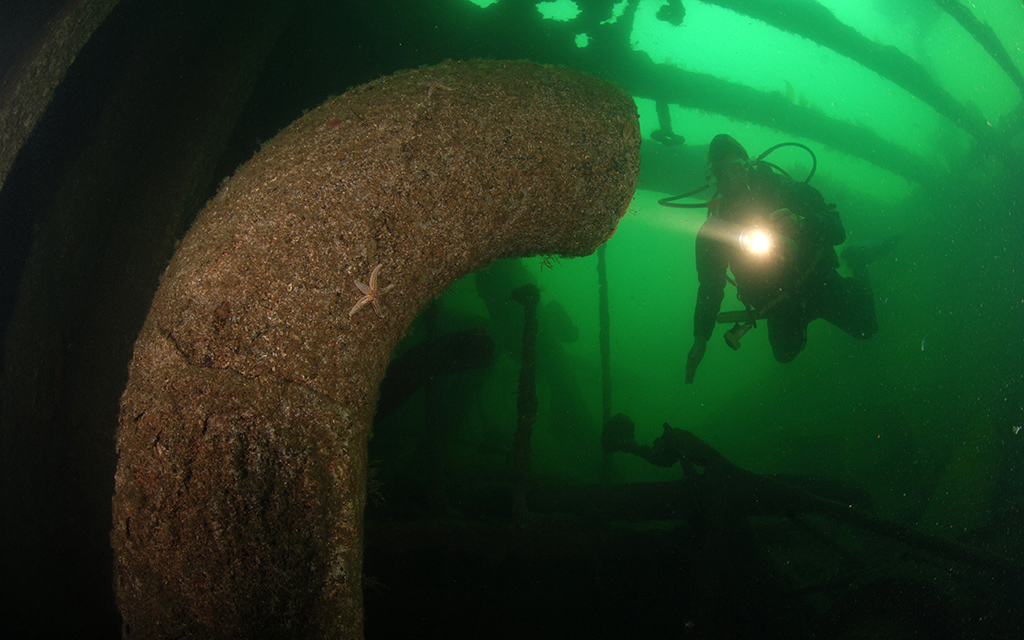
Image by Charles Hood
Jane Maddocks explains how BSAC divers can play a direct role in monitoring and protecting our historic shipwrecks.
There is a new kid on the block, as far as protecting historic wrecks goes, and it has implications for us as divers. For a few years now Historic England (HE) has been scheduling historic wrecks as Monuments of National Importance under the Ancient Monuments and Archaeological Area Act 1979 (AMAA 79). Scheduling is the operative word: it only applies to sites protected under AMMA ’79.
So, what’s new? Well, after much discussion, the AMMA act is now actively covering historic shipwrecks, and that means there are ways for divers to access these sites, and to help in their conservation.
As scheduled ancient monuments, important wrecks can be dived without any need to apply for permission or get licences; we can dive as we wish, when we wish. What we can’t do is interfere with it, move bits around, or remove anything from the wreck – but we are free to dive it. If you want to survey or move stuff, you will have to talk to HE first to sort out permissions.
there are ways for divers to access Protected Wreck sites... and to help in their conservation
As someone who tries to look after a scheduled ancient monument (SS Faith), I do not have any official standing. Divers such as Alison Mayor and her team look after the tanks and bulldozers on the South Coast, and Nick Reed keeps an eye on the Valentine tanks in Swanage Bay.
These sites are all important and I want to try to get some form of diver involvement that means we get updates on the sites, perhaps annually. SS Faith is an Ancient Monument of National Importance; talking to Nick and Alison has made me think about how we can record what happens to these wrecks and this is why I need you.
Since scheduling was applied to wrecks in the last couple of years, 29 have been scheduled - impressive when you consider that there are only 57 sites protected since the ’73 Act was passed 50 years ago.
Wrecks protected under the ’73 Act have an appointed licensee who is responsible for activity on the wreck, applying for the right licenses to do survey, or recovery of artefacts, or even excavation. HE requires an annual report and in general there is a formal structure recognising the wreck and its importance. Obviously, this does cost money, which comes out of the HE budget.
Scheduled wrecks have no licensee, no formal someone who will dive, observe, record, report. There is no mechanism for an annual check to see what is going on. I have had an idea.
Get involved
I want to find six Wreck Champions. A Wreck Champion will be someone who dives one of the scheduled wrecks at least once a year and completes a very short form. I will be very happy to show you how to complete the form, it’s really straightforward. I can offer Hi Vis vests, and support material from the Protected Wrecks Association team.
If you are a Wreck Champion you will be in at the beginning of something that can only benefit divers. Email me at heritage@bsac.com - I would love to have the problem of too many applicants, please!
I don’t want to stop at just the scheduled wrecks from HE. The Protection of Military Remains Act also has two types of protection. A controlled site means no access without permission from the Ministry of Defence, but a Protected Place allows free access with no entry or interference.
I’m going to ask permission from the MOD for divers to do ‘swim-over’ reports on Protected Places and start a small archive from the reports. Each year, I do an informal check on two such sites: HM Submarine Swordfish and the M2. Nothing official, just a swim-over looking for signs of bad behaviour or change.
I am really pleased that I have been asked to work with the Protected Wrecks Association to try to make our sites more visible.
I would like to research the expenses we, as divers, cover when diving on protected sites. So, this year, if you dive a protected wreck or scheduled site, can you just cost up your mileage at 45p per mile, plus boat costs and gas and send it to me at heritage@bsac.com so I can get a fuller picture. The work that volunteers do on our sites is never properly accounted for.
I suspect we save government a good few million each year, and we need evidence of these savings.
Article by Jane Maddocks first published in SCUBA magazine, Issue 134 April 2023.




